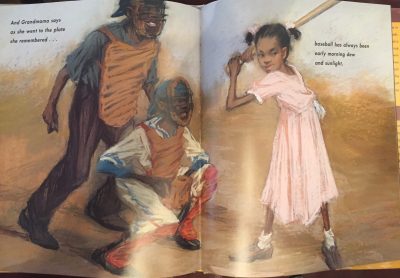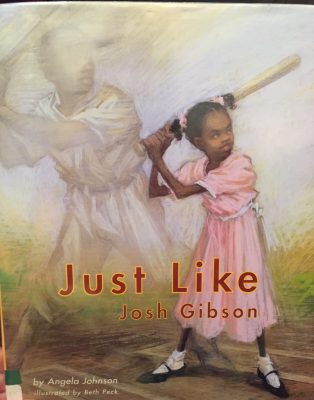- Title: Just Like Josh Gibson
- Author(s): Angela Johnson
- Illustrator/Photographer: Beth Peck
- Publisher and Year: Simon & Schuster, 2004

- Number of pages: 28
- Tags: Morgan Houk, K-5, Diversity, Family, Historical Fiction, Picture Book
- Genre: Historical Fiction
- Analysis:
This story is about a grandmother telling her granddaughter about her days playing baseball when she was young. They are African American and really idolize Josh Gibson who was known as “the Babe Ruth of the Negro Leagues.” Grandmother describes her struggles with trying to play baseball with the boys but being excluded due to her gender, even though she was a much better ball player than many of the boys. During one game, one of the players was hurt so they let grandmother play and they ended up winning the game because of her.
The back of the book has a page that talks about Josh Gibson’s life as an African American athlete during the 1930’s-40’s. It also discusses the many women that have tried to play in the major leagues but have been turned away because of their gender. I believe that this aspect of the story could act as a mirror for many children. It could act as a mirror for children who have been excluded based on their race or gender which, sadly, is something that happens every day. This book could also act as a window for those children who have not yet experienced this which could lead them to the door concept of children’s literature. This book can teach children to be active and stand up for those being oppressed around them.
This book definitely highlights the ideological framework discussed in class. In the story, we see positions of power and how a white person was viewed as superior to a black person and a boy was viewed as superior to a girl during this time and, in some cases, still today. In terms of the perceptual framework identified in the illustrations, grandmother, as a young girl, is always standing out from those around her and her surroundings. It looks as though the illustrations were drawn with pastels. She is drawn with such bright colors whereas the rest of the characters somewhat blend into the neutral background in the story. Throughout the majority of the story, she is drawn much smaller in comparison to the boys playing baseball symbolizing her disadvantage and weakness. In the last couple of pages, she is drawn at a perspective that shows her bigger than some of the boys because she has started winning the game for them and, thus, is stronger and has more power than before.
